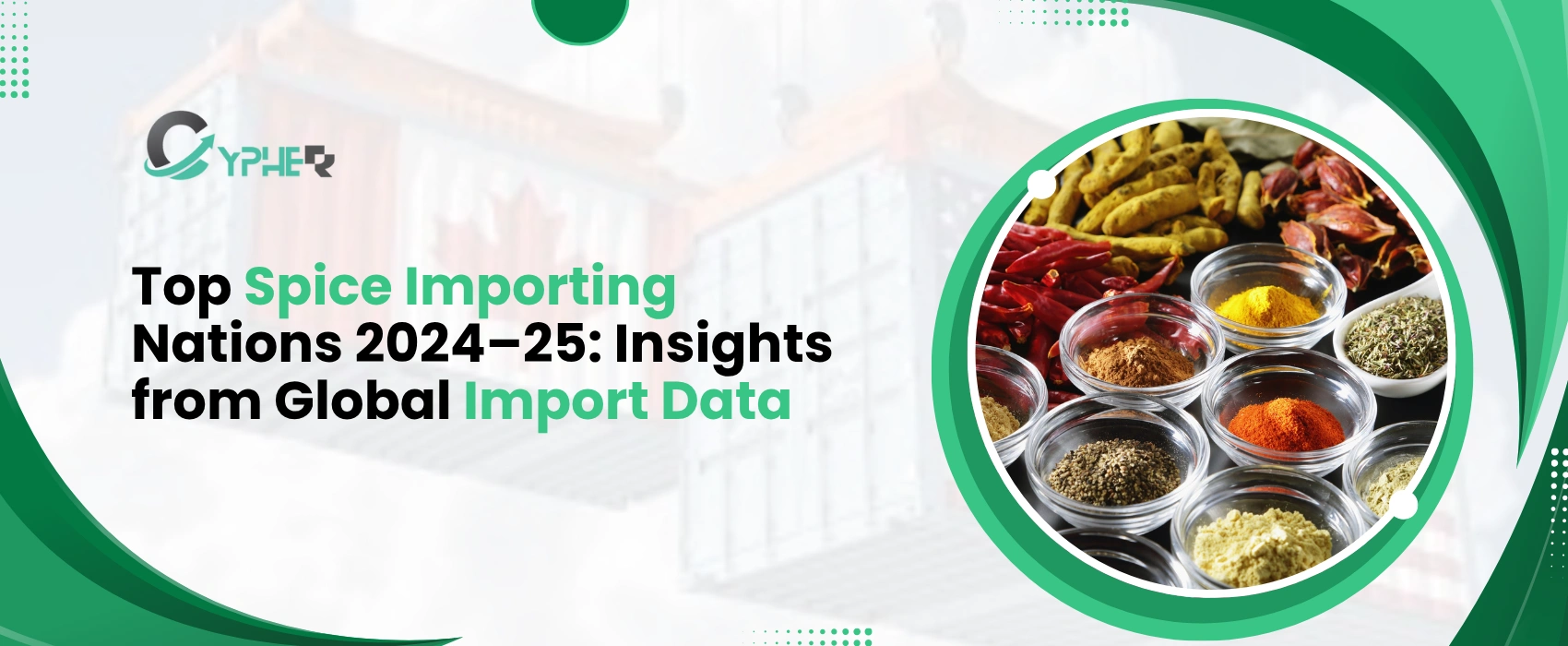Top Spice Importing Nations 2024-25: Insights from Global Import Data

26 Oct 2025
Spices have been part of human life for thousands of years. They add flavor to our meals, help preserve food, and even offer health benefits. From the sharp kick of black pepper to the warm hug of cinnamon, spices make everyday cooking exciting. In today's world, where people love trying new tastes from different cultures, the demand for spices is higher than ever. But not every country grows all the spices it needs. That's where imports come in. Countries buy spices from places that produce them in large amounts. In 2024-25, the global spice import market hit a value of about $4.05 billion, up 4% from the year before. This growth shows how spices are key players in world trade. This blog dives into the top nations importing spices during this period. We'll look at why they import so much, what spices they favor, and what trends shape their choices. By understanding these insights, you can see how global food habits are changing and what it means for the future of spice trade.
The story of spice imports starts with why countries need them. Many top importers are in regions with cold weather or limited farmland for tropical plants. For example, nations in North America and Europe can't easily grow things like turmeric or chilli peppers because of their climate. Instead, they rely on sunny, warm areas like India, Vietnam, and Indonesia, which supply over 80% of the world's spices. In 2024, total global spice imports reached around 4.2 million metric tons. This is close to the pre-pandemic high of 4.4 million tons in 2021. The rise comes from more people cooking at home after the COVID years, plus a boom in ethnic foods like Indian curries or Mexican tacos in Western supermarkets. Health trends also play a big role. Spices like ginger and cumin are now seen as superfoods for digestion and immunity. Reports show the overall spice market grew to $48.7 billion in 2024, with imports driving much of that. Looking ahead to 2025, experts predict a 5% jump in imports as economies recover and travel brings back fusion cuisines.
One big reason for this trade is the variety of spices available. There are over 40 main types traded worldwide, from whole seeds to ground powders. Pepper leads the pack, making up a large chunk of imports because it's used in almost every kitchen. In 2024, pepper imports alone were worth billions. Other stars include chili for heat lovers, turmeric for its golden color and anti-inflammatory perks, and vanilla for sweet treats. These aren't just for home cooks, food companies use them in ready meals, sauces, and snacks. The push for natural ingredients means more imports of organic spices too. For instance, organic ginger exports grew 18% in 2024. But imports aren't without hurdles. Prices fluctuate due to weather issues, like monsoons hitting Indian farms, and rules on safety, such as low pesticide levels in Europe. Still, the flow keeps growing, connecting farmers in Asia to shoppers in the West.
Now, let's spotlight the top spice importing nations for 2024,25. These countries pull in the most shipments by value and volume. They shape the market and show where tastes are heading. The United States sits at number one, with imports worth $466 million in 2024, about 11.5% of the global total. This giant appetite comes from America's mix of cultures. With over 300 million people craving everything from BBQ rubs to Thai curries, U.S. supermarkets stock endless spice aisles. In fact, the U.S. brought in 537,000 tons of spices that year, focusing on pepper, cumin, and blends for fast food. Big chains like McDonald's and home cooks alike drive this demand. Looking at 2025, imports could rise 6% as Hispanic and Asian populations grow, bringing more spice-heavy recipes to dinner tables.
Germany ranks high too, as Europe's spice gateway. In 2024, it imported spices valued at around $250 million. Germans love hearty meals, and spices like paprika and nutmeg add depth to sausages and stews. The country's strict food rules ensure high-quality imports, mostly from India and the Netherlands. With a population of 84 million that's increasingly into vegan and global eats, Germany's imports hit 200,000 tons last year. Trends show a shift to sustainable spices,fair trade certified ones are up 15%. For 2025, expect more focus on herbs mixed with spices for health teas, as wellness shops boom.
The United Kingdom follows close behind, importing $220 million worth in 2024. Post-Brexit, the UK sources from former colonies like India and Sri Lanka for cinnamon and curry powders. British kitchens blend old favorites like cloves in mince pies with new ones like sumac in Middle Eastern dishes. Imports totaled 180,000 tons, with pepper and ginger leading. The multicultural vibe in cities like London fuels this,over 30% of residents are from spice-rich regions. In 2025, online grocery sales could push imports higher, as people experiment with home fusion cooking.
China, despite being a top producer, is a surprise importer at fourth place with $200 million in 2024. It brings in 391,000 tons, mainly pepper and star anise from Vietnam and Indonesia, to meet its massive domestic needs. China's 1.4 billion people use spices in stir-fries and traditional medicine. The middle class's love for bold flavors has spiked demand. For 2025, imports might grow 7% as e-commerce platforms sell spice kits for home chefs.
India rounds out the top five, importing $180 million worth even as it exports billions. This is for specialty items like vanilla and saffron that don't grow well locally. With 1.4 billion mouths to feed, India imports 250,000 tons to fill gaps in its diverse regional cuisines,from Kashmiri saffron rice to South Indian pepper rasam. In 2025, rising incomes could mean more premium imports for urban millennials.
Other key players include the Netherlands ($150 million), a trade hub that re-exports to Europe; Japan ($140 million), loving wasabi and ginger for sushi; the United Arab Emirates ($130 million), blending spices for Arab sweets; France ($120 million), using herbes de Provence mixes; and Canada ($110 million), mirroring U.S. tastes with multicultural twists. Together, these top 10 handle over 70% of global spice imports. Their choices highlight a world where spices cross borders as easily as ideas.
Diving deeper into the United States, its spice imports tell a story of diversity and convenience. In 2024, the U.S. sourced 40% of its spices from India, 20% from Vietnam, and the rest from Mexico and China. Pepper was the biggest, at 150,000 tons, used in everything from burgers to craft beers. Turmeric imports jumped 20% thanks to its popularity in golden milk lattes and anti-inflammatory supplements. The health angle is huge,sales of spice-based wellness products rose 12% last year. Challenges include supply chain snags from Red Sea tensions, raising costs by 5%. But innovations like pre-mixed taco seasonings keep demand steady. For 2025, the U.S. might see more organic imports as eco-labels become must-haves. This not only flavors food but supports global farmers.
Germany's import scene is all about quality and tradition. It pulls in cumin and coriander for Turkish kebabs, popular among its immigrant communities. In 2024, imports from India hit $100 million, with the rest from Turkey and Spain. The country's green push means 30% of spices are now organic, certified by EU standards. Nuremberg, a historic spice trade center, still hosts big markets. Rising veganism,up 15%,boosts demand for spice rubs on plant meats. Prices stabilized in 2024 after inflation, but 2025 could bring hikes if droughts hit suppliers. Germany's role as Europe's distributor means its trends ripple outward.
In the United Kingdom, curry houses number over 12,000, guzzling imported chilies and garam masala. 2024 saw $80 million from India alone, with ginger up for tea infusions. The UK's love for baking drives cinnamon imports for scones. Post-pandemic, home cooking surged, with spice sales online up 25%. Sustainability matters,fair trade spices grew 10%. For 2025, expect more spice-infused craft gins and beers as mixology booms.
China's imports focus on volume for its factories and homes. Star anise for five-spice powder led at 100,000 tons. From Vietnam, it got 60% of its pepper. The Belt and Road Initiative smooths trade routes. Urban youth drive fancy imports like Moroccan ras el hanout for social media recipes. In 2025, health regulations might tighten, favoring cleaner spices.
India's imports, though smaller, are strategic. It brings in Brazilian black pepper when local yields dip and Iranian saffron for luxury dishes. This keeps prices low for consumers. With domestic production at 11 million tons, imports plug holes. 2025 might see more vanilla from Madagascar as ice cream demand rises.
The Netherlands acts as a spice superhighway, importing $150 million and re-exporting 70%. Rotterdam port handles chili from China and cloves from Indonesia. Its advanced processing adds value, like grinding for EU labels.
Japan imports ginger for pickles and sansho pepper for washoku. Precision in sourcing ensures no contaminants, with 2024 volumes at 80,000 tons.
The UAE mixes imports for its expat population, favoring cardamom for kahwa tea. Dubai's markets buzz with global blends.
France imports haute cuisine, with nutmeg in bechamel sauces. Provence herbs blend with imports.
Canada's imports echo the U.S., with curry powders for Indo-Canadian families.
These nations share trends: a shift to organic and traceable spices. In 2024, global organic spice imports rose 15%, driven by labels like Rainforest Alliance. Health benefits shine, turmeric sales up for curcumin extracts. Sustainability fights climate change; programs in India train farmers for drought-resistant crops.
E-commerce changes everything. Platforms like Amazon sell spice subscription boxes, boosting small imports. In 2024, online spice sales grew 25% in India and the U.S. Fusion foods, like Korean-Indian tacos, mix imports creatively.
Challenges loom: geopolitical issues like Ukraine tensions raise logistics costs 10 %. Pests and weather cut supplies, spiking prices 8% for pepper. Regulations vary, EU's pesticide limits reject 5% of Asian shipments.
For 2025, the outlook is bright. Global imports could hit $4.25 billion, with Asia-Pacific growing fastest at 6%. Top nations will lead, pushing for ethical sourcing. Tech like blockchain tracks spices from farm to fork, building trust.
In wrapping up, the top spice importing nations of 2024–25 show a flavorful world connected by taste. From U.S. barbecues to German sausages, spices bridge cultures. As demand grows, so does the need for fair trade, green practices, and reliable insights from the Export Import Bank and Export Import Data Bank. Whether you’re a cook or a trader, these insights reveal the power of spices to unite. Next time you sprinkle cumin, think of the global journey it took—the spice trade isn’t just business, it’s a tasty thread in our shared story.







